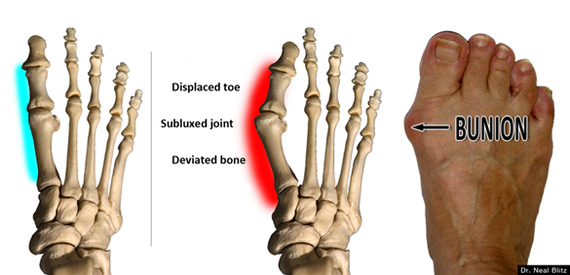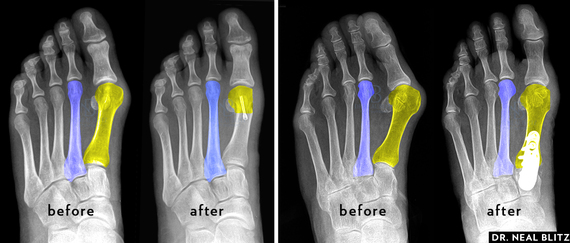
Some foot surgeons already knew that Dr. Oz's advice was somewhat misleading when it came to bunion surgery, but now a Canadian research study indicates that Dr. Oz's overall advice may be not be backed up with facts when it comes to other conditions as well.
Television show doctors are under fire because a new research study demonstrated that "one out of three recommendations from The Dr. Oz Show has believable evidence, and about half of the recommendations on The Doctors has believable evidence," according to a statement made by the study's authors.
In 2013, The Dr. Oz Show aired a segment entitled "Should You Have Bunion Surgery," where he interviewed Judge Marilyn Milian (from The People's Court) regarding her experience after being eight weeks post-bunion surgery. In short, Judge Milian's bunion surgery (revision bunion surgery, by the way) experience was poisoned by a very painful recovery and significant immobility with what appeared to be 6-8 weeks of not being able to walk (crutches and cast/surgical boot). In the end, she appears to be favorable about her overall result.
Some foot surgeons have been upset with Dr. Oz for his misrepresentation of bunion surgery as "The Surgery You Should Say No To" because he is making this claim based the poor experience of a single person, and he also does a poor job demonstrating how bunions are surgically corrected in todays modern age.
As a Manhattan bunion surgeon, I am not particularly disappointed with Dr. Oz's segment or the inaccuracies in it, because it brings the spotlight to a condition that many people don't want to talk about -- BUNIONS. Several women may find bunions a sensitive issue altogether, so hats off to Judge Milian for sharing a medical issue with the public. Additionally, such a segment on bunion surgery only drives those with the problem to dig deeper, become more educated, and seek out face-to-face consults with foot health professionals.
So, what are the real answers to the questions that were raised about bunion surgery?
1. What Exactly Is A Bunion?
A bunion is problem involving the alignment of big toe joint causing the boney knobby bump on the inside of the foot. Dr. Oz got this one right.

2. Do Bunions Come Back After Bunion Surgery?
Bunion surgery is curative in the majority of people. In my revision bunion surgery practice, I find a common reason for bunions to return are that the bunion was not treated with the best bunion operation for that particular bunion in the first place. When bunions do recur, they tend to recur slowly over time. In Judge Milian's case, she indicated that she had a first bunion surgery in her 20s that involved a simple sawing of the bunion.
3. Just How Painful Is Bunion Surgery?
Bunion surgery, just like any surgery, can be painful. Foot surgery in particular gets a bad rap regarding post-operative pain because the pressure from the foot hanging down aggravates the nerves. In general, there are three days of discomfort after bunion surgery, and the severity is based a patient's overall pain threshold. Everyones experience is different. For those with low pain tolerances, advanced anesthesia techniques can get patients through this time. Here are some bunion surgery preparation tips to help with the recovery and ease the discomfort.
4. How Are Bunions Surgically Corrected?
Bunion surgeons generally use a handful of techniques to fix the bunion depending on its severity. Small bunions are surgically treated differently than large bunions, and recurrent bunions may be treated differently than both of those.
Small bunion surgery often involves a realigning bone cut near the big toe joint. Large bunion surgery involves treatment further back on the maligned bone through a bone cut or a bone mending procedure of a non-essential joint in the foot.
While Dr. Oz did discuss a bone cutting method, he particularly highlighted an archaic procedure for his hands-on demonstration (called an exostectomy), which is rarely performed in isolation today. This bunion shaving procedure is the exact surgery that Judge Milian describes that lead to her bunion return decades later.
4. Are Knee-High Casts/Boots Needed?
This topic was touched on as Judge Milian was walking in a knee-high boot. Most bunion surgery today allows for a small surgical shoe, especially for the mild bunions. Larger bunions are more complex as some surgeons will require a cast/boot whereas others allow for the small surgical shoe. Modern techniques have made knee high casts/boots somewhat obsolete with bunion surgery.
5. Do You Need Crutches For Many Weeks Following Bunion Surgery?
The need for crutches after bunion surgery generally involves large bunions, is variable based on the stability/strength of the bunion repair, and a surgeon's confidence of that repair to heal with weightbearing pressure. As a surgeon who pioneered the ability to walk immediately after bunion surgery with the development of a patented medical implant, the need for non-weightbearing with crutches has become obsolete for most -- even for the largest of bunions.
Read on HuffPost: "Walking After Bunion Surgery: Is it Possible?"
6. Are The Incisions Unsightly?
It would be great if all bunions required the exact same surgery and surgeons all approached bunion surgery the same way, but that is not the case. Some surgeons are able to perform bunion surgery in a minimally invasive nature to keep scarring at a minimum. Additionally modern approaches can keep incisions to the inside of the foot. In Judge Milan's case she discussed multiple incisions, which may be related to the the revisional aspect of her surgery.
Read on HuffPost: "Bunionplasty: A Plastic Foot Surgery Craze."
Bunion Surgery: Don't Rely Solely On TV To Make Medical Decisions
While doctors on television are providing medical information, they are doing so informally in a broad and general nature. These are still television show productions with limited time to present a problem or topic, not to mention the need to get ratings. When it comes to bunion surgery, or any other issue, it is best to become educated on the topic and see a doctor for a doctor-to-patient medical advice.
Dr. Neal Blitz
Reconstructive Foot & Ankle Surgery
New York City
To Learn More About Bunion Surgery Manhattan, please visit
www.BunionSurgeryNY.com

